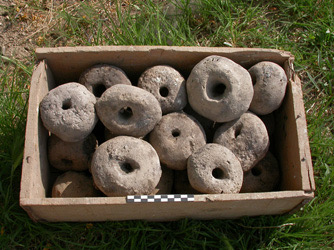As most textile researchers point out before they make statements with any certainty about the early origins of knitting, attributing the development of knitting to a specific time and place is a difficult task because textiles are most often made of organic substances that easily wear and rot. This makes it difficult to assign a date to knitting’s discovery. But more important to our story about the origins of knitting along the Wood Roads, it makes it hard to say where and how knitting as a technique traveled around the globe. Was it developed in several places at once? Was it taught by Arab traders to villagers across Europe, or by shipwrecked Spanish sailors to the people of the Fair Isles in Scotland? Which came first, knitting or crochet? Most sources agree that knitting was preceded by netting and knotting, and nålbinding. Volumes have been written and histories summarized, but the consensus is that knitting most likely developed in the Middle East and was spread through trade routes – effectively, the original Wool Road.
In the academic world, knitting does not get a lot of space compared to weaving. Most stories of the evolution of textiles begin, logically enough, with gathering and preparing wool and the development of spinning fluff into yarn, but then jump precipitously to weaving as if that were a divine and pre-ordained progression. What about knotting, netting, and knitting? Or the early arts of sprang and nålbinding? These seem incidental to many researchers in their haste to get to the prize – the development of weaving.
Cultural bias on the part of the storytellers themselves might also make it difficult to trace the evolution of knitting. Where fiber arts were women’s work, or artifacts were ephemeral in nature and used only in the home, they may have been deemed too humble to be worth cataloging or describing. Ethnocentrism may also have something to do with the lack of detail about knitting’s origins. For example, some historians attribute the origin of a type of knitted lace called Punto in Aria or Stitch in the Air to the time of its arrival in Venice, Italy despite evidence that the technique arrived there from Asia with trade ships and therefore had a longer history.

The most-documented craft of wool manufacture on the Wool Roads is weaving, not knitting. One might say that the focus on weaving is warranted. The economic argument for weaving is patent: with a bit of preparation, one person can create a volume of material in short order – the resulting fabric is lighter and is smoother than knitted fabric. On the downside, while some types of looms are very portable, knitting wins if you want to be productive while you carry a load of kindling on your back while leading your sheep back home. These chapters focus on knitting but incorporate themes from weaving cultures in order to reclaim the legendary properties of wool, celebrated in both arts.
